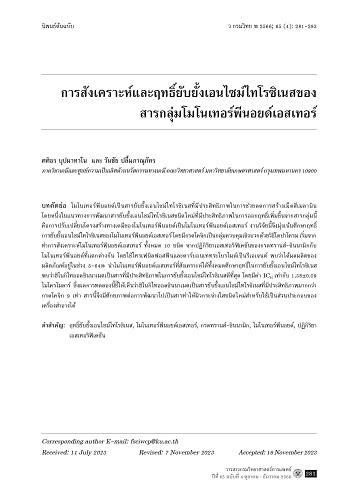การสังเคราะห์และฤทธิ์ยับยั้งเอนไซม์ไทโรซิเนสของ สารกลุ่มโมโนเทอร์พีนอยด์เอสเทอร์
ฤทธิ์ยับยั้งไทโรซิเนสของโมโนเทอร์พีนอยด์เอสเทอร์
คำสำคัญ:
ฤทธิ์ยับยั้งเอนไซม์ไทโรซิเนส, โมโนเทอร์พีนอยด์เอสเทอร์, กรดทรานส์-ซินนามิก, โมโนเทอร์พีนอยด์, ปฏิกิริยาเอสเทอริฟิเคชันบทคัดย่อ
โมโนเทอร์พีนอยด์เป็นสารยับยั้งเอนไซม์ไทโรซิเนสที่มีประสิทธิภาพในการช่วยลดการสร้างเม็ดสีเมลานินโดยหนึ่งในแนวทางการพัฒนาสารยับยั้งเอนไซม์ไทโรซิเนสชนิดใหม่ที่มีประสิทธิภาพในการออกฤทธิ์เพิ่มขึ้นจากสารกลุ่มนี้คือการปรับเปลี่ยนโครงสร้างทางเคมีของโมโนเทอร์พีนอยด์เป็นโมโนเทอร์พีนอยด์เอสเทอร์ งานวิจัยนี้จึงมุ่งเน้นศึกษาฤทธิ์การยับยั้งเอนไซม์ไทโรซิเนสของโมโนเทอร์พีนอยด์เอสเทอร์ โดยมีกรดโคจิกเป็นกลุ่มควบคุมเชิงบวกด้วยวิธีโดปาโครม เริ่มจากทำการสังเคราะห์โมโนเทอร์พีนอยด์เอสเทอร์ ทั้งหมด 10 ชนิด จากปฏิกิริยาเอสเทอริฟิเคชันของกรดทรานส์-ซินนามิกกับโมโนเทอร์พีนอยด์ที่แตกต่างกัน โดยใช้ไทรเฟนิลฟอสฟีนและคาร์บอนเททระโบรไมด์เป็นรีเอเจนต์ พบว่าได้ผลผลิตของผลิตภัณฑ์อยู่ในช่วง 5−64% นำโมโนเทอร์พีนอยด์เอสเทอร์ที่สังเคราะห์ได้ทั้งหมดศึกษาฤทธิ์ในการยับยั้งเอนไซม์ไทโรซิเนสพบว่าฮิโนกิไทออลซินนาเมตเป็นสารที่มีประสิทธิภาพในการยับยั้งเอนไซม์ไทโรซิเนสดีที่สุด โดยมีค่า IC50 เท่ากับ 1.58±0.09 ไมโครโมลาร์ ซึ่งผลการทดลองนี้ชี้ให้เห็นว่าฮิโนกิไทออลซินนาเมตเป็นสารยับยั้งเอนไซม์ไทโรซิเนสที่มีประสิทธิภาพมากกว่ากรดโคจิก 9 เท่า สารนี้จึงมีศักยภาพต่อการพัฒนาไปเป็นสารทำให้ผิวกระจ่างใสชนิดใหม่สำหรับใช้เป็นส่วนประกอบของเครื่องสำอางได้
เอกสารอ้างอิง
Bae-Harboe YS, Park HY. Tyrosinase: a central regulatory protein for cutaneous pigmentation. J Invest Dermatol 2012; 132(12): 2678-80.
Wang W, Gao Y, Wang W, Zhang J, Yin J, Le T, et al. Kojic acid showed consistent inhibitory activity on tyrosinase from mushroom and in cultured B16F10 cells compared with arbutins. Antioxidants 2022; 11(3): 502. (14 pages).
Zolghadri S, Bahrami A, Hassan Khan MT, Munoz-Munoz J, Garcia-Molina F, Garcia-Canovas F, et al. A comprehensive review on tyrosinase inhibitors. J Enzyme Inhib Med Chem 2019; 34(1): 279-309.
Shi Y, Chen QX, Wang Q, Song KK, Qiu L. Inhibitory effects of cinnamic acid and its derivatives on the diphenolase activity of mushroom (Agaricus bisporus) tyrosinase. Food Chem 2005; 92(4): 707-12.
Sarkar R, Chugh S, Garg VK. Newer and upcoming therapies for melasma. Indian J Dermatol Venereol Leprol 2012; 78(4): 417-28.
Manosroi A, Manosroi J. Free radical scavenging and tyrosinase inhibition activity of aromatic volatile oil from Thai medicinal plants for cosmetic uses. Acta Hort 2005; 680: 97-100.
Cui Y, Hu YH, Yu F, Zheng J, Chen LS, Chen QX, et al. Inhibition kinetics and molecular simulation of p-substituted cinnamic acid derivatives on tyrosinase. Int J Biol Macromol 2017; 95: 1289-97.
Brotzman N, Xu Y, Graybill A, Cocolas A, Ressler A, Seeram NP, et al. Synthesis and tyrosinase inhibitory activities of 4-oxobutanoate derivatives of carvacrol and thymol. Bioorg Med Chem Lett 2019; 29(1):56-8.
Furuya T, Matsuura Y, Takahara S. New hinokitiol derivative and skin care preparation containing the same. Application No.JP2002371039A. Osaka, Japan: Patent Application Publication; 2002.
Sheng Z, Ge S, Xu X, Zhang Y, Wu P, Zhang K, et al. Design, synthesis and evaluation of cinnamic acid ester derivatives as mushroom tyrosinase inhibitors. Med Chem Commun 2018; 9(5): 853-61.
Pluempanupat W, Chavasiri W. An efficient method for chlorination of alcohols using PPh3/Cl3CCONH2. Tetrahedron Lett 2006; 47(38): 6821-3.
Chaysripongkul S, Pluempanupat W, Jang DO, Chavasiri W. Application of Cl3CCONH2/PPh3 towards the synthesis of bioactive amides. Bull Korean Chem Soc 2009; 30(9): 2066-70.
Tharamak S, Yooboon T, Pengsook A, Ratwatthananon A, Kumrungsee N, Bullangpoti V, et al. Synthesis of thymyl esters and their insecticidal activity against Spodoptera litura (Lepidoptera: Noctuidae). Pest Manag Sci 2020; 76(3): 928-35.
Mutschlechner B, Rainer B, Schwaiger S, Stuppner H. Tyrosinase inhibitors from the aerial parts of Wulfenia carinthiaca Jacq. Chem Biodivers 2018; 15(4): e1800014. (8 pages).
Alni A, Fauzia SE, Mujahidin D. Synthesis of eugenyl cinnamate from clove oil (Syzygium aromaticum) via bromination-dehydrobromination methods. Pure App Chem Res 2019; 8(2): 140-6.
Huang C, Li J, Wang J, Zheng Q, Li Z, Tu T. Hydrogen-bond-assisted transition-metalfree catalytic transformation of amides to esters. Sci China Chem 2021; 64(1): 66-71.
Kumar A, Singh SP, Chhokar SS. Antimicrobial activity of the major isolates of mentha oil and derivatives of menthol. Anal Chem Lett 2011; 1(1): 70-85.
Gonçalves RO, Farias IF, Silva MF, Pessoa CÓ, Zocolo GJ, Zampieri D, et al. Preparation, spectral characterization and anticancer potential of cinnamic esters. J Braz Chem Soc 2021; 32: 1931-42.
Chen W. Jie W, Jin-Hua G, Lian-Bao Y. Alpha-pinene derivative and preparation method and application thereof. Application No. CN105481857A. Guangdong, China: Guangdong Pharmaceutical University; 2016.
Wu D, Nair MG, DeWitt DL. Novel compounds from Piper methysticum Forst (Kava Kava) roots and their effect on cyclooxygenase enzyme. J Agric Food Chem 2002; 50(4): 701-5.
Zanetti M, Carniel TK, Valério A, Oliveira JV,Oliveira DD, Araújo PH, et al. Synthesis of geranyl cinnamate by lipase-catalyzed reaction and its evaluation as an antimicrobial agent. J Chem Technol Biotechnol 2017; 92(1): 115-21.
Alam N, Yoon KN, Cha YJ, Kim JH, Lee KR, Lee TS. Appraisal of the antioxidant, phenolic compounds concentration, xanthine oxidase and tyrosinase inhibitory activities of Pleurotus salmoneostramineus. Afr J Agric Res 2011; 6(6): 1555-63.
Takahashi T, Miyazawa M. Tyrosinase inhibitory activities of cinnamic acid analogues. Pharmazie 2010; 65(12): 913-8.
Uchida R, Ishikawa S, Tomoda H. Inhibition oftyrosinase activity and melanine pigmentation by 2-hydroxytyrosol. Acta Pharm Sin B 2014; 4(2): 141-5.
Song S, Lee H, Jin Y, Ha YM, Bae S, Chung HY, et al. Syntheses of hydroxy substituted 2-phenyl-naphthalenes as inhibitors of tyrosinase. Bioorg Med Chem Lett 2007; 17(2): 461-4.

ดาวน์โหลด
เผยแพร่แล้ว
รูปแบบการอ้างอิง
ฉบับ
ประเภทบทความ
สัญญาอนุญาต
ลิขสิทธิ์ (c) 2023 วารสารกรมวิทยาศาสตร์การแพทย์

อนุญาตภายใต้เงื่อนไข Creative Commons Attribution-NonCommercial-NoDerivatives 4.0 International License.



